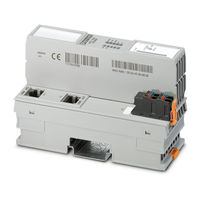User Manuals: Phoenix Contact 2701295 Controller
Manuals and User Guides for Phoenix Contact 2701295 Controller. We have 1 Phoenix Contact 2701295 Controller manual available for free PDF download: User Manual
Phoenix Contact 2701295 User Manual (162 pages)
Brand: Phoenix Contact
|
Category: Controller
|
Size: 3 MB
Table of Contents
Advertisement
